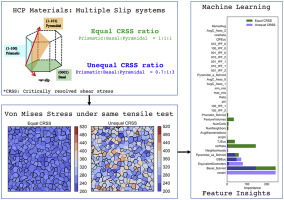当前位置:
X-MOL 学术
›
Int. J. Plasticity
›
论文详情
Our official English website, www.x-mol.net, welcomes your
feedback! (Note: you will need to create a separate account there.)
Applied Machine Learning to Predict Stress Hotspots II: Hexagonal close packed materials
International Journal of Plasticity ( IF 9.4 ) Pub Date : 2019-03-01 , DOI: 10.1016/j.ijplas.2018.08.003 Ankita Mangal , Elizabeth A. Holm
International Journal of Plasticity ( IF 9.4 ) Pub Date : 2019-03-01 , DOI: 10.1016/j.ijplas.2018.08.003 Ankita Mangal , Elizabeth A. Holm

|
Stress hotspots are regions of stress concentrations that form under deformation in polycrystalline materials. We use a machine learning approach to study the effect of preferred slip systems and microstructural features that reflect local crystallography, geometry, and connectivity on stress hotspot formation in hexagonal close packed materials under uniaxial tensile stress. We consider two cases: one without any preferred slip systems with a critically resolved shear stress (CRSS) ratio of 1:1:1, and a second with CRSS ratio 0.1:1:3 for basal: prismatic: pyramidal slip systems. Random forest based machine learning models predict hotspot formation with an AUC (area under curve) score of 0.82 for the Equal CRSS and 0.81 for the Unequal CRSS cases. The results show how data driven techniques can be utilized to predict hotspots as well as pinpoint the microstructural features causing stress hotspot formation in polycrystalline microstructures
中文翻译:

应用机器学习预测应力热点 II:六边形密堆积材料
应力热点是多晶材料在变形下形成的应力集中区域。我们使用机器学习方法来研究首选滑移系统和微观结构特征的影响,这些特征反映了局部晶体学、几何学和连通性对在单轴拉伸应力下六方密堆积材料中应力热点形成的影响。我们考虑两种情况:一种没有任何首选滑移系统,临界解析剪切应力 (CRSS) 比为 1:1:1,另一种情况下,CRSS 比为 0.1:1:3 的基础:棱柱形:金字塔形滑移系统。基于随机森林的机器学习模型预测热点形成,AUC(曲线下面积)得分为 0.82(对于 Equal CRSS 和 0.81 对于 Unequal CRSS 案例)。
更新日期:2019-03-01
中文翻译:

应用机器学习预测应力热点 II:六边形密堆积材料
应力热点是多晶材料在变形下形成的应力集中区域。我们使用机器学习方法来研究首选滑移系统和微观结构特征的影响,这些特征反映了局部晶体学、几何学和连通性对在单轴拉伸应力下六方密堆积材料中应力热点形成的影响。我们考虑两种情况:一种没有任何首选滑移系统,临界解析剪切应力 (CRSS) 比为 1:1:1,另一种情况下,CRSS 比为 0.1:1:3 的基础:棱柱形:金字塔形滑移系统。基于随机森林的机器学习模型预测热点形成,AUC(曲线下面积)得分为 0.82(对于 Equal CRSS 和 0.81 对于 Unequal CRSS 案例)。









































 京公网安备 11010802027423号
京公网安备 11010802027423号